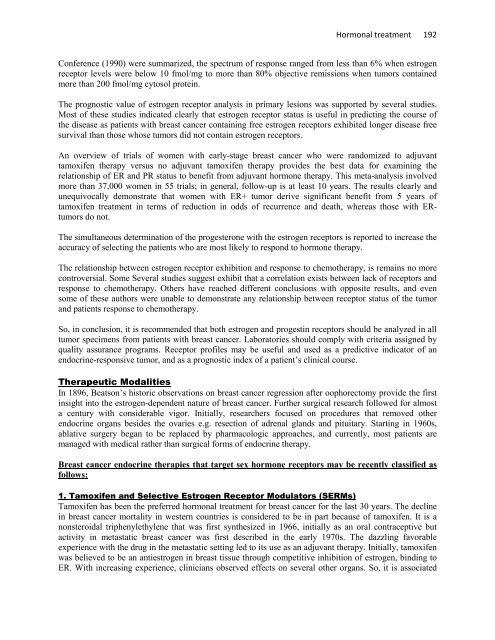Breast Cancer - Arab Medical Association Against Cancer
Breast Cancer - Arab Medical Association Against Cancer
Breast Cancer - Arab Medical Association Against Cancer
- No tags were found...
You also want an ePaper? Increase the reach of your titles
YUMPU automatically turns print PDFs into web optimized ePapers that Google loves.
Hormonal treatment 192Conference (1990) were summarized, the spectrum of response ranged from less than 6% when estrogenreceptor levels were below 10 fmol/mg to more than 80% objective remissions when tumors containedmore than 200 fmol/mg cytosol protein.The prognostic value of estrogen receptor analysis in primary lesions was supported by several studies.Most of these studies indicated clearly that estrogen receptor status is useful in predicting the course ofthe disease as patients with breast cancer containing free estrogen receptors exhibited longer disease freesurvival than those whose tumors did not contain estrogen receptors.An overview of trials of women with early-stage breast cancer who were randomized to adjuvanttamoxifen therapy versus no adjuvant tamoxifen therapy provides the best data for examining therelationship of ER and PR status to benefit from adjuvant hormone therapy. This meta-analysis involvedmore than 37,000 women in 55 trials; in general, follow-up is at least 10 years. The results clearly andunequivocally demonstrate that women with ER+ tumor derive significant benefit from 5 years oftamoxifen treatment in terms of reduction in odds of recurrence and death, whereas those with ERtumorsdo not.The simultaneous determination of the progesterone with the estrogen receptors is reported to increase theaccuracy of selecting the patients who are most likely to respond to hormone therapy.The relationship between estrogen receptor exhibition and response to chemotherapy, is remains no morecontroversial. Some Several studies suggest exhibit that a correlation exists between lack of receptors andresponse to chemotherapy. Others have reached different conclusions with opposite results, and evensome of these authors were unable to demonstrate any relationship between receptor status of the tumorand patients response to chemotherapy.So, in conclusion, it is recommended that both estrogen and progestin receptors should be analyzed in alltumor specimens from patients with breast cancer. Laboratories should comply with criteria assigned byquality assurance programs. Receptor profiles may be useful and used as a predictive indicator of anendocrine-responsive tumor, and as a prognostic index of a patient’s clinical course.Therapeutic ModalitiesIn 1896, Beatson’s historic observations on breast cancer regression after oophorectomy provide the firstinsight into the estrogen-dependent nature of breast cancer. Further surgical research followed for almosta century with considerable vigor. Initially, researchers focused on procedures that removed otherendocrine organs besides the ovaries e.g. resection of adrenal glands and pituitary. Starting in 1960s,ablative surgery began to be replaced by pharmacologic approaches, and currently, most patients aremanaged with medical rather than surgical forms of endocrine therapy.<strong>Breast</strong> cancer endocrine therapies that target sex hormone receptors may be recently classified asfollows:1. Tamoxifen and Selective Estrogen Receptor Modulators (SERMs)Tamoxifen has been the preferred hormonal treatment for breast cancer for the last 30 years. The declinein breast cancer mortality in western countries is considered to be in part because of tamoxifen. It is anonsteroidal triphenylethylene that was first synthesized in 1966, initially as an oral contraceptive butactivity in metastatic breast cancer was first described in the early 1970s. The dazzling favorableexperience with the drug in the metastatic setting led to its use as an adjuvant therapy. Initially, tamoxifenwas believed to be an antiestrogen in breast tissue through competitive inhibition of estrogen, binding toER. With increasing experience, clinicians observed effects on several other organs. So, it is associated









